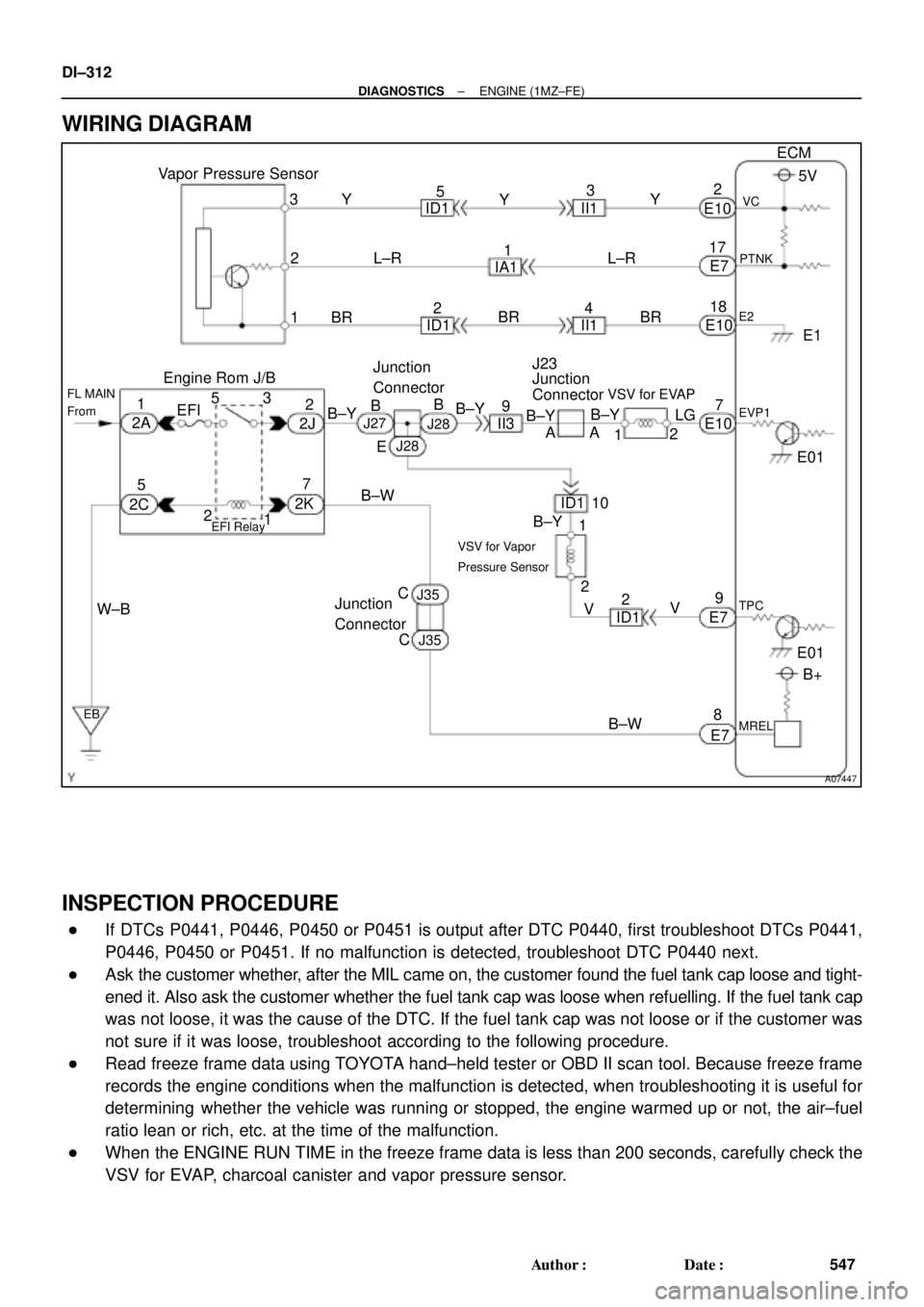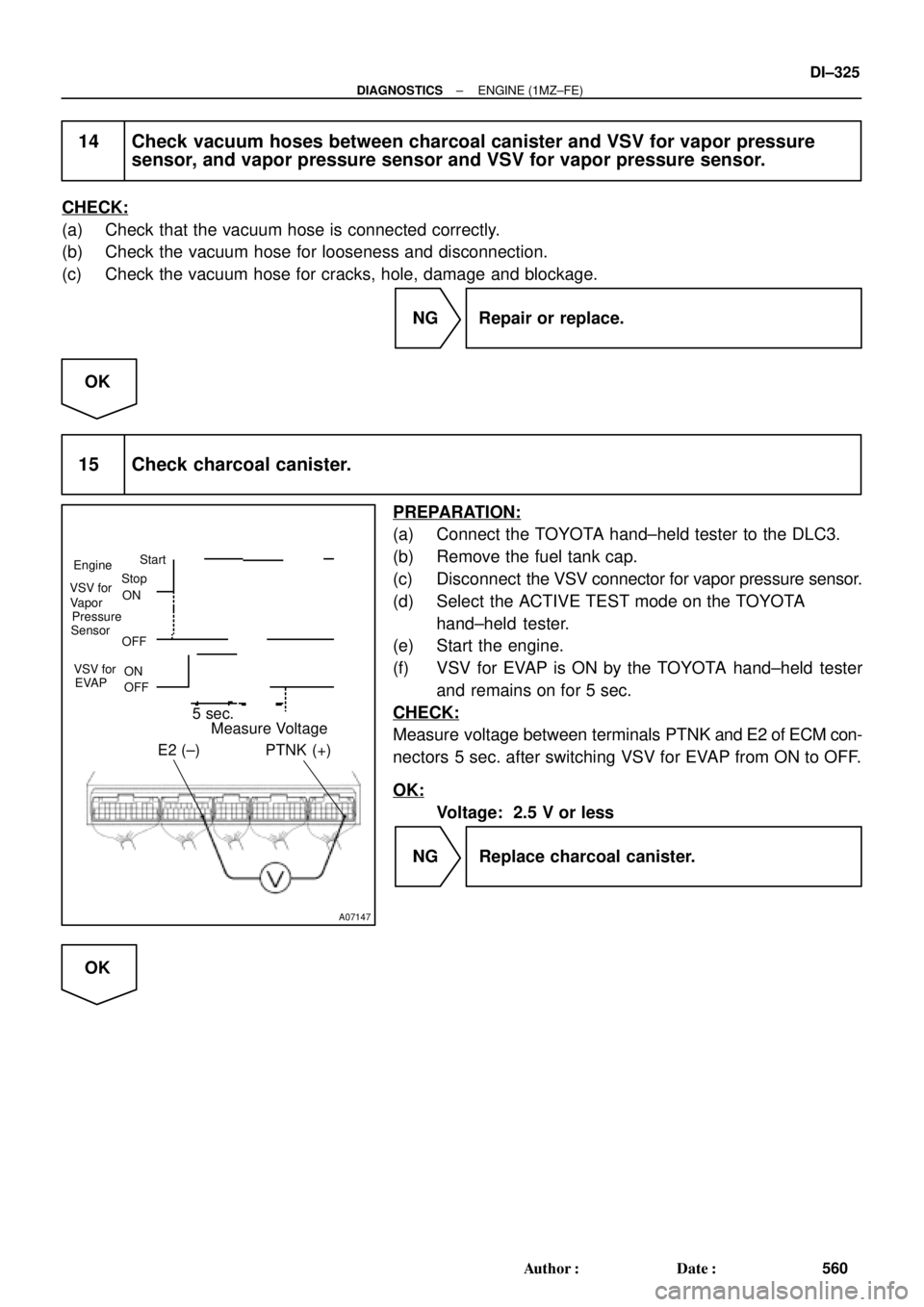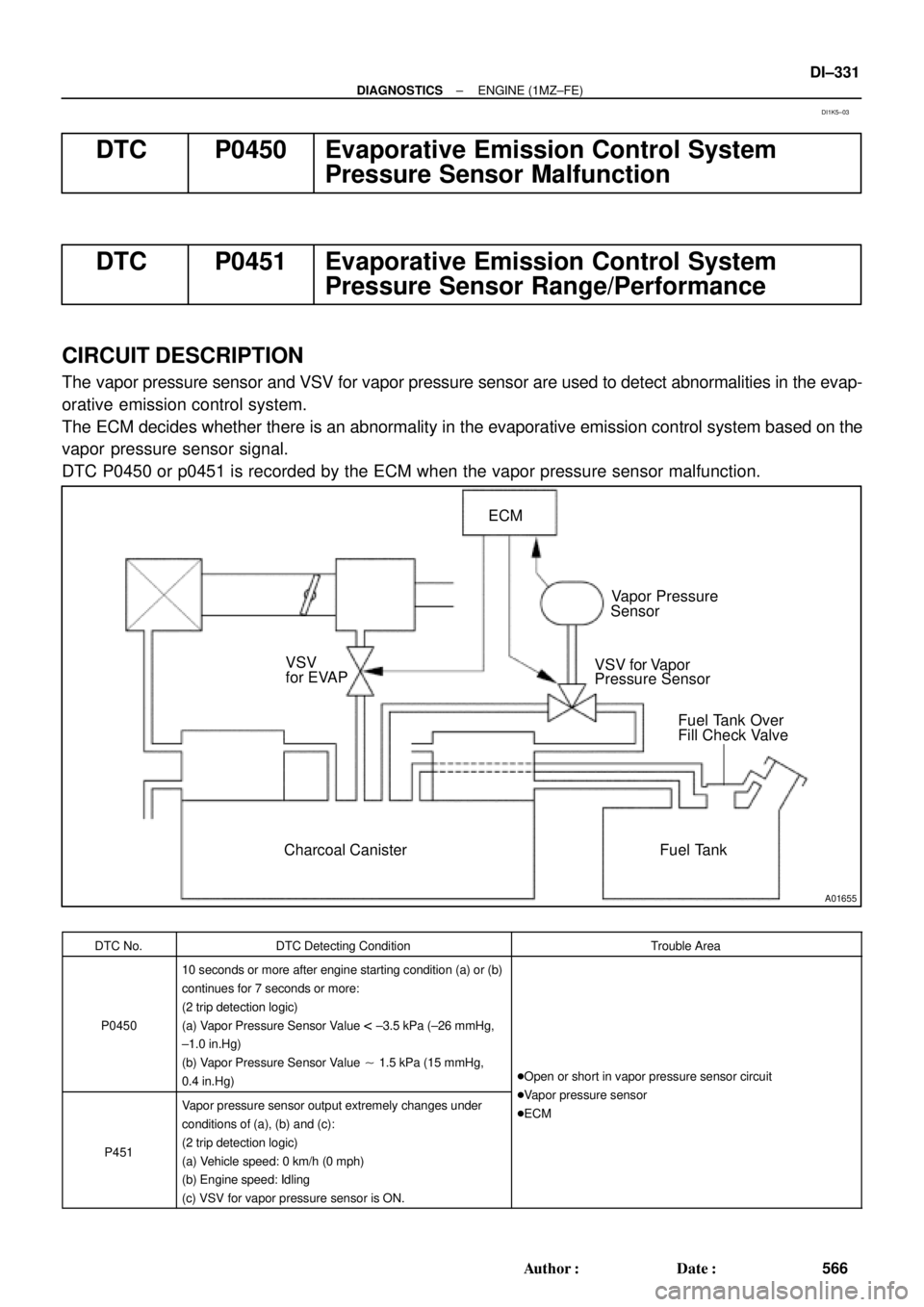Page 1524 of 4592

A07447
Vapor Pressure Sensor
2J2
9J23
B±Y
V
VSV for EVAP
LG
AA
2
1ECM
5V
VC
PTNK
E1
E2
EVP1
E01
E01
TPC
3
2
Engine Rom J/B
MREL VSV for Vapor
Pressure Sensor
II3
EB
B±W
W±BL±R Y
1BRE10
E7
E10
E72
17
18
7
9
E78
EFI Relay
IA1 L±RY Y
ID1 II13
5
1
II1 BR
BR
ID1 E10
B±Y
J28 J27
B
ID1 10
1
2
ID12 2A
7 1
2C5
2K 53
2
1 EFI
B±WFL MAIN
From
24
B+
J28E B±YB
B±Y
B±Y
V
J35
J35C
C Junction
Connector
Junction
ConnectorJunction
Connector DI±312
± DIAGNOSTICSENGINE (1MZ±FE)
547 Author�: Date�:
WIRING DIAGRAM
INSPECTION PROCEDURE
�If DTCs P0441, P0446, P0450 or P0451 is output after DTC P0440, first troubleshoot DTCs P0441,
P0446, P0450 or P0451. If no malfunction is detected, troubleshoot DTC P0440 next.
�Ask the customer whether, after the MIL came on, the customer found the fuel tank cap loose and tight-
ened it. Also ask the customer whether the fuel tank cap was loose when refuelling. If the fuel tank cap
was not loose, it was the cause of the DTC. If the fuel tank cap was not loose or if the customer was
not sure if it was loose, troubleshoot according to the following procedure.
�Read freeze frame data using TOYOTA hand±held tester or OBD II scan tool. Because freeze frame
records the engine conditions when the malfunction is detected, when troubleshooting it is useful for
determining whether the vehicle was running or stopped, the engine warmed up or not, the air±fuel
ratio lean or rich, etc. at the time of the malfunction.
�When the ENGINE RUN TIME in the freeze frame data is less than 200 seconds, carefully check the
VSV for EVAP, charcoal canister and vapor pressure sensor.
Page 1526 of 4592
DI±314
± DIAGNOSTICSENGINE (1MZ±FE)
549 Author�: Date�:
5 Check filler neck for damage.
PREPARATION:
Remove the fuel tank cap.
CHECK:
Visually inspect the filler neck for damage.
NG Replace filler pipe.
OK
6 Check vacuum hoses between vapor pressure sensor and VSV for vapor
pressure sensor, and VSV for vapor pressure sensor and charcoal canister
(See page EC±3 , SF±62 and EC±6).
CHECK:
(a) Check that the vacuum hose is connected correctly.
(b) Check the vacuum hose for looseness and disconnection.
(c) Check the vacuum hose for cracks, hole and damage.
NG Repair or replace.
OK
7 Check hose and tube between fuel tank and charcoal canister.
CHECK:
(a) Check for proper connection of the fuel tank and fuel evap pipe (See page SF±1), fuel evap pipe and
fuel tube under the floor, fuel tube under the floor and charcoal canister.
(b) Check the hose and tube for cracks, hole and damage.
NG Repair or replace.
OK
Page 1530 of 4592
A01654
ECM
Vapor Pressure
Sensor
VSV for Vapor
Pressure Sensor
Fuel Tank Charcoal Canister VSV
for EVAP(1)
(2)
(3) (4)
(5) fig. 1
(6)
(7)
(8)
(9)Fuel Tank Over
Fill Check Valve DI±318
± DIAGNOSTICSENGINE (1MZ±FE)
553 Author�: Date�:
DTC P0441 Evaporative Emission Control System
Incorrect Purge Flow
DTC P0446 Evaporative Emission Control System Vent
Control Malfunction
CIRCUIT DESCRIPTION
The vapor pressure sensor and VSV for vapor pressure sensor are used to detect abnormalities in the evap-
orative emission control system.
The ECM decides whether there is an abnormality in the evaporative emission control system based on the
vapor pressure sensor signal.
DTCs P0441 and P0446 are recorded by the ECM when evaporative emissions leak from the components
within the dotted line in fig. 1 below, or when there is a malfunction in either the VSV for EVAP, the VSV for
vapor pressure sensor, or in the vapor pressure sensor itself.
DI080±07
Page 1531 of 4592

± DIAGNOSTICSENGINE (1MZ±FE)
DI±319
554 Author�: Date�:
DTC No.DTC Detecting ConditionTrouble Area
Pressure in charcoal canister does not drop during purge con-
trol (2 trip detection logic)
P0441During purge cut±off, pressure in charcoal canister is very low
compared with atmospheric pressure
(2 trip detection logic)�Open or short in VSV circuit for EVAP
�Open or short in VSV circuit for vapor pressure sensor
�
Open or short in vaporpressure sensor circuit
When VSV for vapor pressure sensor is OFF, ECM judges that
there is no continuity between vapor pressure sensor and
charcoal canister (2 trip detection logic)
�Open or short in vapor pressure sensor circuit
�VSV for EVAP
�VSV for vapor pressure sensor
�Vapor pressure sensor
P0446
When VSV for vapor pressure sensor is ON, ECM judges that
there is no continuity between vapor pressure sensor and fuel
tank (2 trip detection logic)
Va o r ressure sensor
�Vacuum hose cracks, holed blocked, damaged or
disconnected ((1), (4), (5),(6) and (7) in fig. 1)
�Charcoal canister cracks, holed or damaged
F l t k fill h k l k d d dAfter purge cut off operates, pressure in charcoal canister is
maintained at atmospheric pressure
(2 trip detection logic)�Fuel tank over fill check valve cracked or damaged
WIRING DIAGRAM
Refer to DTC P0440 (Evaporative Emission Control System Malfunction) on page DI±311 for the WIRING
DIAGRAM.
INSPECTION PROCEDURE
HINT:
�If DTCs P0441, P0446, P0450 or P0451 is output after DTC P0440, first troubleshoot DTCs P0441,
P0446, P0450 or P0451. If no malfunction is detected, troubleshoot DTC P0440 next.
�Read freeze frame data using TOYOTA hand±held tester or OBD II scan tool. Because freeze frame
records the engine conditions when the malfunction is detected, when troubleshooting it is useful for
determining whether the vehicle was running or stopped, the engine warmed up or not, the air±fuel
ratio lean or rich, etc. at the time of the malfunction.
�When the ENGINE RUN TIME in the freeze frame data is less than 200 seconds, carefully check the
VSV for EVAP, charcoal canister and vapor pressure sensor.
TOYOTA hand±held tester
1 Check VSV connector for EVAP, VSV connector for vapor pressure sensor and
vapor pressure sensor connector for looseness and disconnection.
NG Repair or connect VSV or sensor connector.
OK
Page 1537 of 4592

A07147
E2 (±) PTNK (+)
EngineStart
Stop
OFF ON OFF VSV for
ON
Vapor
Pressure
Sensor
VSV for
EVAP
5 sec.
Measure Voltage
± DIAGNOSTICSENGINE (1MZ±FE)
DI±325
560 Author�: Date�:
14 Check vacuum hoses between charcoal canister and VSV for vapor pressure
sensor, and vapor pressure sensor and VSV for vapor pressure sensor.
CHECK:
(a) Check that the vacuum hose is connected correctly.
(b) Check the vacuum hose for looseness and disconnection.
(c) Check the vacuum hose for cracks, hole, damage and blockage.
NG Repair or replace.
OK
15 Check charcoal canister.
PREPARATION:
(a) Connect the TOYOTA hand±held tester to the DLC3.
(b) Remove the fuel tank cap.
(c) Disconnect the VSV connector for vapor pressure sensor.
(d) Select the ACTIVE TEST mode on the TOYOTA
hand±held tester.
(e) Start the engine.
(f) VSV for EVAP is ON by the TOYOTA hand±held tester
and remains on for 5 sec.
CHECK:
Measure voltage between terminals PTNK and E2 of ECM con-
nectors 5 sec. after switching VSV for EVAP from ON to OFF.
OK:
Voltage: 2.5 V or less
NG Replace charcoal canister.
OK
Page 1538 of 4592
DI±326
± DIAGNOSTICSENGINE (1MZ±FE)
561 Author�: Date�:
16 Remove charcoal canister and check it (See page EC±6).
NG Replace charcoal canister.
OK
17 Check fuel tank over fill check valve (See page EC±2).
NG Replace fuel tank over fill check valve or fuel
tank.
OK
Check and replace ECM (See page IN±31).
OBD II scan tool (excluding TOYOTA hand±held tester)
1 Check VSV connector for EVAP, VSV connector for vapor pressure sensor and
vapor pressure sensor connector for looseness and disconnection.
NG Repair or connect VSV or sensor connector.
OK
2 Check vacuum hoses (1), (4), (5), (6) (7) and (8) on Page DI±311).
CHECK:
(a) Check that the vacuum hose is connected correctly.
(b) Check the vacuum hose for looseness and disconnection.
(c) Check the vacuum hose for cracks, hole, damage and blockage.
NG Repair or replace.
OK
Page 1542 of 4592
DI±330
± DIAGNOSTICSENGINE (1MZ±FE)
565 Author�: Date�:
10 Check operation of VSV for vapor pressure sensor (See page SF±62).
OK Go to step 11.
NG
Replace VSV and clean the vacuum hoses between charcoal canister and VSV for vapor pressure
sensor, and VSV for vapor pressure sensor and vapor pressure sensor, and then check the char-
coal canister.
11 Check for open and short in harness and connector between EFI main relay
(Marking: EFI) and VSV for vapor pressure sensor, and VSV for vapor pressure
sensor and ECM (See page IN±31).
NG Repair or replace harness or connector.
OK
Check and replace ECM (See page IN±31).
12 Check the fuel tank over fill check valve (See page EC±6).
NG Replace fuel tank over fill check valve or fuel
tank.
OK
Check and replace charcoal canister
(See page EC±6).
Page 1543 of 4592

A01655
Charcoal CanisterVapor Pressure
Sensor
VSV for Vapor
Pressure Sensor
Fuel Tank VSV
for EVAPECM
Fuel Tank Over
Fill Check Valve
± DIAGNOSTICSENGINE (1MZ±FE)
DI±331
566 Author�: Date�:
DTC P0450 Evaporative Emission Control System
Pressure Sensor Malfunction
DTC P0451 Evaporative Emission Control System
Pressure Sensor Range/Performance
CIRCUIT DESCRIPTION
The vapor pressure sensor and VSV for vapor pressure sensor are used to detect abnormalities in the evap-
orative emission control system.
The ECM decides whether there is an abnormality in the evaporative emission control system based on the
vapor pressure sensor signal.
DTC P0450 or p0451 is recorded by the ECM when the vapor pressure sensor malfunction.
DTC No.DTC Detecting ConditionTrouble Area
P0450
10 seconds or more after engine starting condition (a) or (b)
continues for 7 seconds or more:
(2 trip detection logic)
(a) Vapor Pressure Sensor Value
< ±3.5 kPa (±26 mmHg,
±1.0 in.Hg)
(b) Vapor Pressure Sensor Value � 1.5 kPa (15 mmHg,
0.4 in.Hg)
�Open or short in vapor pressure sensor circuit
V
P451
Vapor pressure sensor output extremely changes under
conditions of (a), (b) and (c):
(2 trip detection logic)
(a) Vehicle speed: 0 km/h (0 mph)
(b) Engine speed: Idling
(c) VSV for vapor pressure sensor is ON.�Vapor pressure sensor
�ECM
DI1K5±03